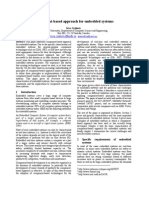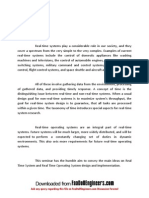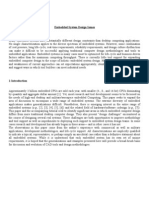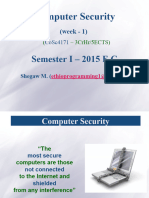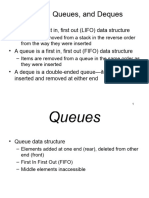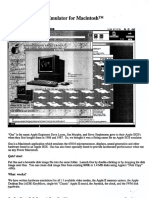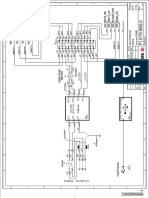0 ratings0% found this document useful (0 votes)
20 viewsRTES Ch1
RTES Ch1
Uploaded by
Oz GThe document discusses real-time and embedded systems. It defines them as systems that respond to events within a specified time frame and are commonly used in industrial control, medical devices, transportation, and military applications. Embedded systems are a type of real-time system integrated into other devices. The document outlines the characteristics, examples, task models, and design process for real-time and embedded systems.
Copyright:
© All Rights Reserved
Available Formats
Download as PDF, TXT or read online from Scribd
RTES Ch1
RTES Ch1
Uploaded by
Oz G0 ratings0% found this document useful (0 votes)
20 views33 pagesThe document discusses real-time and embedded systems. It defines them as systems that respond to events within a specified time frame and are commonly used in industrial control, medical devices, transportation, and military applications. Embedded systems are a type of real-time system integrated into other devices. The document outlines the characteristics, examples, task models, and design process for real-time and embedded systems.
Copyright
© © All Rights Reserved
Available Formats
PDF, TXT or read online from Scribd
Share this document
Did you find this document useful?
Is this content inappropriate?
The document discusses real-time and embedded systems. It defines them as systems that respond to events within a specified time frame and are commonly used in industrial control, medical devices, transportation, and military applications. Embedded systems are a type of real-time system integrated into other devices. The document outlines the characteristics, examples, task models, and design process for real-time and embedded systems.
Copyright:
© All Rights Reserved
Available Formats
Download as PDF, TXT or read online from Scribd
Download as pdf or txt
0 ratings0% found this document useful (0 votes)
20 views33 pagesRTES Ch1
RTES Ch1
Uploaded by
Oz GThe document discusses real-time and embedded systems. It defines them as systems that respond to events within a specified time frame and are commonly used in industrial control, medical devices, transportation, and military applications. Embedded systems are a type of real-time system integrated into other devices. The document outlines the characteristics, examples, task models, and design process for real-time and embedded systems.
Copyright:
© All Rights Reserved
Available Formats
Download as PDF, TXT or read online from Scribd
Download as pdf or txt
You are on page 1of 33
Real time and embedded system
1. Introduction
1.1. Definitions, characteristics and examples of real-time and embedded systems
1.2. Model of real time system
1.3. Types of real time tasks
1.4. Modeling timing constraints
1.5. Computer organization concepts and memory
1.6. Design process
Compiled By Amanuel T. (MSc.) 8/29/2023 1
1.1. Definitions…
• Real-time systems are computer systems that are designed to respond to
events in the environment within a specified time frame.
• Real-time systems are commonly used in industrial control systems,
medical devices, transportation systems, and military applications.
• Embedded systems are a type of real-time system that are integrated into
other devices or systems.
Compiled By Amanuel T. (MSc.) 8/29/2023 2
Cont…..
• They are designed to perform specific functions and operate under specific
environmental conditions.
• Embedded systems typically have limited processing power, memory, and
input/output capabilities compared to general-purpose computers.
• Examples of embedded systems include microcontrollers, automotive
control systems, and home appliances(ex. washing machine).
Compiled By Amanuel T. (MSc.) 8/29/2023 3
Cont….
• Real-time systems are designed to meet specific timing requirements, such
as deadlines, response times, and throughput.
• They must be able to respond to input and generate output within these
specified time structures.
• Timing constraints are a critical component of real-time systems, and they
must be carefully analyzed and modeled during the system design process.
Compiled By Amanuel T. (MSc.) 8/29/2023 4
Cont…..
• There are two types of real-time task models:
• Periodic and aperiodic.
• Periodic tasks are those that occur at regular intervals, such as
generating a report every hour.
• Aperiodic tasks are those that occur irregularly and have no fixed
schedule, such as responding to a user input.
• Real-time systems must be able to handle both types of tasks and ensure
that the timing constraints are met.
Compiled By Amanuel T. (MSc.) 8/29/2023 5
Cont…
• Real-time systems are typically modeled using a four-component model:
• The environment, the system, the control laws, and the plant.
• The environment is the context in which the system operates, including inputs,
outputs, and constraints.
• The system is the hardware and software components that process the inputs and
generate the outputs.
• The control laws define the algorithms and logic that govern the system's behavior.
• The plant refers to the physical processes or devices that the system interacts with.
Compiled By Amanuel T. (MSc.) 8/29/2023 6
Cont……
• Designing real-time and embedded systems is a complex process that
involves several stages, including requirements analysis, system
architecture design, hardware and software design, and testing and
validation.
• Designers must take into account the system's performance requirements,
timing constraints, and environmental constraints.
• They must also ensure that the system is reliable, safe, and secure.
Compiled By Amanuel T. (MSc.) 8/29/2023 7
Cont…
• Real-time and embedded systems are critical components of modern
technology.
• They enable us to automate and control complex processes, improve
safety and efficiency, and enhance our quality of life.
• Understanding the characteristics and design principles of real-time and
embedded systems is essential for developing reliable and effective
systems.
Compiled By Amanuel T. (MSc.) 8/29/2023 8
1.2 Model of real time system
• Real-time systems are designed to meet specific timing requirements, such
as deadlines, response times, and throughput.
• Real-time systems must be carefully designed to ensure that they meet their
timing requirements. This involves analyzing the system's performance,
identifying potential bottlenecks, and improving the system's components and
control laws.
• Real-time systems also require specialized hardware and software, such as
real-time operating systems, specialized processors, and real-time
communication protocols.
Compiled By Amanuel T. (MSc.) 8/29/2023 9
Cont...
• There are four-component models that provides a framework for
understanding and modeling real-time systems.
• Such as environment, hardware and software components, control
laws, and plant.
• By carefully designing and optimizing these components, real-time
systems can meet their timing requirements and provide reliable and
effective solutions for a wide range of applications.
Compiled By Amanuel T. (MSc.) 8/29/2023 10
1.3 Types of real time tasks
• Real-time tasks are classified based on their timing requirements and the
consequences of missing their deadlines.
• Here are the three main types of real-time tasks:
• Hard real-time tasks: These are tasks with strict timing requirements,
where missing a deadline can have catastrophic consequences.
Compiled By Amanuel T. (MSc.) 8/29/2023 11
Cont...
• Hard real-time tasks are typically found in safety-critical applications,
such as medical devices, aerospace, and defense systems.
• Examples of hard real-time tasks include airbag deployment in a car,
missile guidance in a defense system, and insulin delivery in a medical
device.
Compiled By Amanuel T. (MSc.) 8/29/2023 12
Cont...
• Soft real-time tasks: These are tasks with timing requirements that are not
as strict as hard real-time tasks, where missing a deadline may not result
in catastrophic consequences.
• Soft real-time tasks are typically found in multimedia and entertainment
applications, such as video streaming and gaming.
• Examples of soft real-time tasks include video playback, audio version,
and game version.
Compiled By Amanuel T. (MSc.) 8/29/2023 13
Cont...
• Firm real-time tasks: These are tasks with some degree of flexibility in
their timing requirements, but they still have a deadline that needs to be
met with a high probability.
• Missing a deadline in firm real-time tasks can have significant but not
catastrophic consequences.
• Firm real-time tasks are typically found in control and automation
systems, such as process control and robotics.
Compiled By Amanuel T. (MSc.) 8/29/2023 14
Cont...
• Examples of firm real-time tasks include temperature control in a
chemical plant, robotic support control in a manufacturing plant, and
traffic light control in a city.
• In addition to the above types of real-time tasks, there are also periodic
and aperiodic tasks. Periodic tasks are tasks that occur at regular intervals,
while aperiodic tasks are tasks that occur irregularly or unpredictably.
Compiled By Amanuel T. (MSc.) 8/29/2023 15
Cont...
• Both types of tasks can be hard, soft, or firm real-time tasks.
• The classification of real-time tasks is important for designing real-time
systems and for selecting appropriate scheduling algorithms and analysis
techniques.
Compiled By Amanuel T. (MSc.) 8/29/2023 16
1.4 Modeling timing constraints
• Modeling timing constraints is a critical task in many engineering and
design domains.
• Timing constraints refer to the temporal relationships between events,
and they can be expressed in a variety of ways, such as time intervals,
deadlines, arrival times, and execution times.
• Modeling timing constraints involves representing these relationships
mathematically, often using constraint-based programming or discrete
event simulation.
Compiled By Amanuel T. (MSc.) 8/29/2023 17
Cont...
• One common approach to modeling timing constraints is to use a network of
timed automata.
• Timed automata are finite-state machines that include timing variables,
which enable them to model the behavior of systems with timing constraints.
• In this approach, the system is modeled as a collection of automata, each
representing a component of the system, and the relationships between them
are modeled as synchronization constraints.
Compiled By Amanuel T. (MSc.) 8/29/2023 18
Cont...
• The resulting model can be analyzed to verify that the system satisfies its timing
constraints.
• Another approach is to use mathematical programming to model timing
constraints.
• This involves formulating the problem as an optimization problem, with the
objective of minimizing or maximizing a certain quantity subject to the timing
constraints.
• This approach can be used to model a wide range of timing constraints, such as
resource constraints, sequencing constraints, and deadline constraints.
Compiled By Amanuel T. (MSc.) 8/29/2023 19
Cont...
• In addition to these approaches, there are several specialized tools and
frameworks for modeling timing constraints in specific domains, such as
circuit design, robotics, and transportation.
• These tools typically provide a high-level modeling language that
abstracts away the low-level details of the timing constraints, making it
easier for designers and engineers to specify and analyze the timing
requirements of their systems.
Compiled By Amanuel T. (MSc.) 8/29/2023 20
Cont...
• Modeling timing constraints is a challenging task that requires a deep
understanding of both the system being modeled and the tools and
techniques used to represent and analyze its timing behavior.
• With the increasing complexity of modern systems, the importance of
accurate and efficient timing modeling and analysis is becoming ever
more crucial.
Compiled By Amanuel T. (MSc.) 8/29/2023 21
1.5 Computer organization concepts and
memory
• Computer organization refers to the design and implementation of
computer systems, including hardware and software components.
• It includes the study of computer architecture, which involves the
organization and design of the computer's internal components,
• such as the central processing unit (CPU), memory, input/output devices,
and storage devices.
Compiled By Amanuel T. (MSc.) 8/29/2023 22
Cont...
• Memory is a critical component of a computer system.
• It refers to the storage space where data and instructions are stored
temporarily or permanently. There are several types of memory in a
computer system, including:
• Random Access Memory (RAM): It is a volatile memory that stores data
and instructions that the CPU needs to access quickly.
Compiled By Amanuel T. (MSc.) 8/29/2023 23
Cont...
• RAM is generally divided into two types - dynamic RAM (DRAM) and
static RAM (SRAM).
• Read-Only Memory (ROM): It is a non-volatile memory that stores
instructions that are essential for the computer to boot up. The contents of
ROM cannot be changed.
• Cache Memory: It is a high-speed memory that stores frequently
accessed data and instructions. The CPU accesses cache memory much
faster than it accesses RAM.
Compiled By Amanuel T. (MSc.) 8/29/2023 24
Cont...
• Virtual Memory: It is a technique that allows the computer to use hard
disk space as if it were RAM.
• This technique is used when the computer runs out of physical RAM.
• The organization of memory in a computer system is typically
hierarchical, with different levels of memory arranged in layers.
Compiled By Amanuel T. (MSc.) 8/29/2023 25
Cont...
• The CPU first looks for data and instructions in the cache memory, then
in RAM, and finally in secondary storage devices such as hard disks and
solid-state drives.
• Memory management is an important concept in computer organization.
Compiled By Amanuel T. (MSc.) 8/29/2023 26
Cont...
• It refers to the allocation and management of memory resources in a
computer system.
• Memory management techniques include virtual memory, calling,
segmentation, and swapping.
• These techniques are used to ensure that the computer system has enough
memory to run multiple applications simultaneously without crashing or
slowing down.
Compiled By Amanuel T. (MSc.) 8/29/2023 27
1.6 Design process
• The design process for an embedded system involves several steps,
including:
• Define the system requirements: The first step in designing an embedded
system is to define the system requirements.
• This involves identifying the specific functions that the system needs to
perform, as well as any hardware or software constraints that need to be
taken into account.
Compiled By Amanuel T. (MSc.) 8/29/2023 28
Cont...
• Select the appropriate hardware platform: Once the system requirements have
been defined, the next step is to select the appropriate hardware platform for the
system.
• This may involve selecting a microcontroller or microprocessor, as well as any
other necessary components such as sensors or communication interfaces.
• Develop the software architecture: The software architecture of the embedded
system needs to be developed.
• This involves dividing the system into different software modules and defining
their interfaces and interactions.
Compiled By Amanuel T. (MSc.) 8/29/2023 29
Cont...
• Write the software code: The software code for the embedded system needs to be
written, using the selected programming language and development tools.
• This may involve writing code for the different software modules, as well as
integrating them into a complete system.
• Test and debug the system: Once the software code has been written, the system
needs to be tested and debugged.
• This involves running the system in a real-world environment and identifying and
fixing any issues or bugs that are encountered.
Compiled By Amanuel T. (MSc.) 8/29/2023 30
Cont...
• Integrate the system: After the software code has been tested and debugged,
the system needs to be integrated with the selected hardware platform.
• This involves connecting the hardware components and testing the integrated
system to ensure that it works as intended.
• Deploy the system: Finally, the embedded system can be deployed, which
may involve installing it in a specific device or environment.
• Ongoing maintenance and support may also be required to ensure that the
system continues to function properly over time.
Compiled By Amanuel T. (MSc.) 8/29/2023 31
Cont...
• Throughout the design process, it is important to consider factors such as
power consumption, size, and cost,
• As these can have a significant impact on the overall performance and
usability of the embedded system.
• Effective communication and collaboration between team members, as
well as thorough testing and documentation, are also essential to ensure
that the design process is successful.
Compiled By Amanuel T. (MSc.) 8/29/2023 32
Compiled By Amanuel T. (MSc.) 8/29/2023 33
You might also like
- Discrete Event Simulation Book by Jerry BanksDocument325 pagesDiscrete Event Simulation Book by Jerry BanksAditya Dhal80% (5)
- Final Exam System Analysis and Design IT Second YearDocument6 pagesFinal Exam System Analysis and Design IT Second Yearg55555100% (4)
- Communications, Navigation and Identification (CNI) Avionics For The F-35 Lightning IIDocument2 pagesCommunications, Navigation and Identification (CNI) Avionics For The F-35 Lightning IIjhawkes100% (1)
- Unit-3 - Advanced Operating Systems-23pcsce24-3Document15 pagesUnit-3 - Advanced Operating Systems-23pcsce24-3Friends of GADGETSNo ratings yet
- Software Metrics For Real Time ApplicationDocument7 pagesSoftware Metrics For Real Time ApplicationmstradersgojraNo ratings yet
- Introduction To MechatronicsDocument19 pagesIntroduction To Mechatronicsanshjaiswal679No ratings yet
- Design of Mechatronics SystemDocument28 pagesDesign of Mechatronics SystemMamo ZelalemNo ratings yet
- Use of Simulation in Manufacturing and Logistics Systems PlanningDocument24 pagesUse of Simulation in Manufacturing and Logistics Systems PlanningIngi Abdel Aziz SragNo ratings yet
- Rtos-Real-time Operating Systems: EchaloneDocument39 pagesRtos-Real-time Operating Systems: EchaloneTobe EziashiNo ratings yet
- Real Time System ShekharDocument58 pagesReal Time System Shekhar220863No ratings yet
- DESS Mod 1 N 2Document65 pagesDESS Mod 1 N 2Ayush RajNo ratings yet
- Asset Integrity ExplanationDocument20 pagesAsset Integrity ExplanationMohammed AljawharNo ratings yet
- Chapter 1 RTSDocument12 pagesChapter 1 RTStejaswini9348No ratings yet
- SAD Unit 4 Real Time Systems1Document20 pagesSAD Unit 4 Real Time Systems1onesnoneNo ratings yet
- RtEmbSysSurvey StankovicDocument4 pagesRtEmbSysSurvey Stankovicashutoshupadhyay849No ratings yet
- Quantum-Inspired Algorithms in Structural EngineeringDocument4 pagesQuantum-Inspired Algorithms in Structural EngineeringRahul SinghNo ratings yet
- os term paperDocument18 pagesos term papernrpawar2149No ratings yet
- System Modeling: PRESSENTED BY:-Er. Saurabh MalpotraDocument36 pagesSystem Modeling: PRESSENTED BY:-Er. Saurabh MalpotraCr ZyNo ratings yet
- 01 Lec IntroDocument33 pages01 Lec Intromujtabaiftikhar156No ratings yet
- Real-Time Computing (RTC), or Reactive Computing, IsDocument5 pagesReal-Time Computing (RTC), or Reactive Computing, IsAchal ShantharamNo ratings yet
- Operating SystemDocument14 pagesOperating SystemC. SwethaNo ratings yet
- Component Based On Embedded SystemDocument6 pagesComponent Based On Embedded Systemu_mohitNo ratings yet
- No Absen 5Document16 pagesNo Absen 5AliJunkoNo ratings yet
- Real Time SystemDocument61 pagesReal Time SystemJitendra KumarNo ratings yet
- 1680722035826real Time System 1Document60 pages1680722035826real Time System 1vkrjpt1997No ratings yet
- Ref Gri02 RTT Eurostar MG BLDocument13 pagesRef Gri02 RTT Eurostar MG BLapi-3738458No ratings yet
- RTOS - Real Time Operating SystemsDocument36 pagesRTOS - Real Time Operating Systemsrs0728No ratings yet
- Self Study Assignment - (1) Aos Batch 5Document10 pagesSelf Study Assignment - (1) Aos Batch 5subash13spNo ratings yet
- Special Issue Time CriticalDocument2 pagesSpecial Issue Time CriticalNoor AdilNo ratings yet
- Mechatronics: by Ajay Kumar VermaDocument17 pagesMechatronics: by Ajay Kumar VermaAjay VermaNo ratings yet
- Project Report On Industrial AutomationDocument15 pagesProject Report On Industrial AutomationAtul KirtiNo ratings yet
- FEA-MECHANICAL 2010 Student VersionDocument89 pagesFEA-MECHANICAL 2010 Student Versionamir_siddiqNo ratings yet
- Multi-Agent Systems For Industrial Applications: Design, Development, and ChallengesDocument27 pagesMulti-Agent Systems For Industrial Applications: Design, Development, and Challengeshyoung65No ratings yet
- Introduction To Simulation & Modelling: Week 1Document61 pagesIntroduction To Simulation & Modelling: Week 1putri_dIYANiNo ratings yet
- History of Modeling and Simulation (Dubois, 2018) : Project of The United States in Partnership With The United Kingdom AnDocument3 pagesHistory of Modeling and Simulation (Dubois, 2018) : Project of The United States in Partnership With The United Kingdom AnBarbie DisneyNo ratings yet
- EME PPT Unit-5 - ElectiveDocument37 pagesEME PPT Unit-5 - ElectivesudeepkoreaNo ratings yet
- Rts Notes 1Document8 pagesRts Notes 1akashanuragi421No ratings yet
- Mechatronics Course SyllabusDocument17 pagesMechatronics Course Syllabusnikhilrane91_7522800No ratings yet
- Unit IDocument54 pagesUnit ISrivatsan SureshNo ratings yet
- Unit-5 MechatronicsDocument34 pagesUnit-5 Mechatronicsrudrav3210No ratings yet
- Real Time Operating SystemDocument1 pageReal Time Operating Systemninja6101999No ratings yet
- Nfo433-Information SecurityDocument244 pagesNfo433-Information Securitymercymatsvayi2001No ratings yet
- Homework Real TimeDocument9 pagesHomework Real Timeahmed.gammam1999No ratings yet
- Overview of OtDocument40 pagesOverview of OtNaman Ku SangerNo ratings yet
- Mpmec12 Industral Engineering and ManagementDocument38 pagesMpmec12 Industral Engineering and ManagementNITIN NAUTIYALNo ratings yet
- Architecture For Modeling and Simulation SIMITDocument17 pagesArchitecture For Modeling and Simulation SIMITLuis Jonathan Bahamaca Fernandez100% (1)
- Ec8791 LNDocument418 pagesEc8791 LNGanapathi RamNo ratings yet
- Unit III: 3.1 Introduction To Real Time SystemsDocument36 pagesUnit III: 3.1 Introduction To Real Time SystemsRoseNo ratings yet
- Application of Queuing Theory in Construction IndustryDocument7 pagesApplication of Queuing Theory in Construction Industryabhay100% (1)
- A Cost Effective Simulation Algorithm FoDocument40 pagesA Cost Effective Simulation Algorithm FoSimon van BentenNo ratings yet
- Introduction To Real-Time SystemsDocument26 pagesIntroduction To Real-Time SystemsHamdan MahatNo ratings yet
- Simulation of Manufacturing SystemsDocument4 pagesSimulation of Manufacturing SystemsJackrobin Vc JNo ratings yet
- Slides 1 General Introduction To Embedded SystemsDocument45 pagesSlides 1 General Introduction To Embedded SystemsTayab MemonNo ratings yet
- Module 1 Embedded System - KtuDocument16 pagesModule 1 Embedded System - KtuSarathchandran SNo ratings yet
- System EngineeringDocument11 pagesSystem Engineeringapi-26349602100% (2)
- Simulation, Modelling FOR Manufacturing Systems: Ravinder Jhorar 2011PMM5173Document32 pagesSimulation, Modelling FOR Manufacturing Systems: Ravinder Jhorar 2011PMM5173Ravinder JhorarNo ratings yet
- Embedded System Design IssuesDocument12 pagesEmbedded System Design IssuesSudhanshu Singh RajputanaNo ratings yet
- Embedded Systems Programming with C++: Real-World TechniquesFrom EverandEmbedded Systems Programming with C++: Real-World TechniquesNo ratings yet
- Practical Control of Electric Machines: Model-Based Design and SimulationFrom EverandPractical Control of Electric Machines: Model-Based Design and SimulationNo ratings yet
- Machine Reliability and Condition Monitoring: A Comprehensive Guide to Predictive Maintenance PlanningFrom EverandMachine Reliability and Condition Monitoring: A Comprehensive Guide to Predictive Maintenance PlanningRating: 4.5 out of 5 stars4.5/5 (2)
- Practical, Made Easy Guide To Building, Office And Home Automation Systems - Part OneFrom EverandPractical, Made Easy Guide To Building, Office And Home Automation Systems - Part OneNo ratings yet
- Security - Chapter 1Document34 pagesSecurity - Chapter 1Oz GNo ratings yet
- F - DataBase Chapter - 4Document17 pagesF - DataBase Chapter - 4Oz GNo ratings yet
- Software Engineering Chapter 1Document42 pagesSoftware Engineering Chapter 1Oz GNo ratings yet
- Chapter 1Document16 pagesChapter 1Oz GNo ratings yet
- OOP - Chapter 2Document9 pagesOOP - Chapter 2Oz GNo ratings yet
- Chapter Two SlideDocument33 pagesChapter Two SlideOz GNo ratings yet
- Chapter 5Document48 pagesChapter 5Oz GNo ratings yet
- QueueDocument41 pagesQueueOz GNo ratings yet
- OOP Chapter 1Document22 pagesOOP Chapter 1Oz GNo ratings yet
- OOp Chapter 3Document7 pagesOOp Chapter 3Oz GNo ratings yet
- Functional Dependency (FD)Document14 pagesFunctional Dependency (FD)Oz GNo ratings yet
- F - DataBase Chapter 1Document10 pagesF - DataBase Chapter 1Oz GNo ratings yet
- Join now-WPS OfficeDocument7 pagesJoin now-WPS OfficeOz GNo ratings yet
- Wireless Chapter 4,5,6Document88 pagesWireless Chapter 4,5,6Oz GNo ratings yet
- Chapter 6 Mobile (Cellular) NetworkDocument30 pagesChapter 6 Mobile (Cellular) NetworkOz GNo ratings yet
- Wachemo University Durame: CampusDocument38 pagesWachemo University Durame: CampusOz GNo ratings yet
- CH 1Document30 pagesCH 1Oz GNo ratings yet
- Chapter 4 Java ScriptDocument22 pagesChapter 4 Java ScriptOz GNo ratings yet
- Chapter 3 - Developing - A - Cost - Effective - Strategy - For - Wireless - CommunicationDocument9 pagesChapter 3 - Developing - A - Cost - Effective - Strategy - For - Wireless - CommunicationOz GNo ratings yet
- Algorithem Chapter OneDocument43 pagesAlgorithem Chapter OneOz GNo ratings yet
- Web AssignmentDocument12 pagesWeb AssignmentOz GNo ratings yet
- Tashe DocDocument23 pagesTashe DocOz GNo ratings yet
- CISCO CCNA1 Chapter 6 Ethiopian Digital LibraryDocument5 pagesCISCO CCNA1 Chapter 6 Ethiopian Digital LibraryOz GNo ratings yet
- 142 New PPT Chapter 4Document62 pages142 New PPT Chapter 4Oz GNo ratings yet
- Chapter - 1 A - Mobile ComputingDocument64 pagesChapter - 1 A - Mobile ComputingOz G100% (1)
- Mahfudzah OthmanDocument206 pagesMahfudzah OthmanOz GNo ratings yet
- ITPM Dessalew-2 210170130208Document43 pagesITPM Dessalew-2 210170130208Oz GNo ratings yet
- Project TryDocument5 pagesProject TryOz GNo ratings yet
- CISCO CCNA1 Chapter 11 Ethiopian Digital LibraryDocument4 pagesCISCO CCNA1 Chapter 11 Ethiopian Digital LibraryOz GNo ratings yet
- Chapter 1Document36 pagesChapter 1Oz GNo ratings yet
- ME8094 CIMs SyllabusDocument1 pageME8094 CIMs SyllabusJeganNo ratings yet
- Power Quality Improvementin Low Voltage Transmission SystemDocument15 pagesPower Quality Improvementin Low Voltage Transmission SystemDungNo ratings yet
- K-Poss 22 operator manualDocument4 pagesK-Poss 22 operator manualvasile.fedulNo ratings yet
- MRI Oasis Velocity Data SheetDocument12 pagesMRI Oasis Velocity Data Sheet33387217No ratings yet
- DR - Babasaheb Ambedkar Technological UniversityDocument1 pageDR - Babasaheb Ambedkar Technological Universityakashkangule5No ratings yet
- Session - GuS - IIgs Emulator - KerwoodDocument7 pagesSession - GuS - IIgs Emulator - KerwoodAlex TirrellNo ratings yet
- UNDP Quantum User Guide For Suppliers October Edition PDFDocument111 pagesUNDP Quantum User Guide For Suppliers October Edition PDFShahadath HossenNo ratings yet
- CHAPTER 2 Data RepresentationsDocument16 pagesCHAPTER 2 Data RepresentationsOkwir EdmondNo ratings yet
- YonoDocument8 pagesYonoShubhamBiyaniNo ratings yet
- My ProjectDocument39 pagesMy ProjectADEOYE JAMES100% (1)
- Yealink SIP-T21P E2 DatasheetDocument2 pagesYealink SIP-T21P E2 DatasheetAdhy NoegrohoNo ratings yet
- Installation Procedure of Orcad PSPICE 9.2: April 2014Document50 pagesInstallation Procedure of Orcad PSPICE 9.2: April 2014ChAmirShokatGujjarNo ratings yet
- Automated FSM Error Correction For Single Event UpsetsDocument5 pagesAutomated FSM Error Correction For Single Event Upsetsكورسات هندسيةNo ratings yet
- III Phrase Sampler User ManualDocument27 pagesIII Phrase Sampler User ManualjpleNo ratings yet
- Prachi Admm Conference PaperDocument4 pagesPrachi Admm Conference PaperGanesh AnandNo ratings yet
- Bundling With WebpackDocument3 pagesBundling With WebpackKrishna ChivukulaNo ratings yet
- Exercise Set 3.1Document15 pagesExercise Set 3.1josh77022No ratings yet
- 07 - MSOFTX3000 SBC SIP Introduce - 201306 V2 1Document43 pages07 - MSOFTX3000 SBC SIP Introduce - 201306 V2 1A . ZAFER SAFRAN100% (1)
- 1.2BitcoinLab NewDocument5 pages1.2BitcoinLab NewfintechNo ratings yet
- 2.2 - Markowitz Portfolio OptimisationDocument24 pages2.2 - Markowitz Portfolio OptimisationMuhammad MuhaiminNo ratings yet
- MM391 - Practical ManualDocument6 pagesMM391 - Practical ManualRishu SinhaNo ratings yet
- General Schematic - CR30-XDocument9 pagesGeneral Schematic - CR30-XPatou PatriceNo ratings yet
- OCC WokingDocument20 pagesOCC WokingTPC 78No ratings yet
- The Impact and Application of 3D Printing Technology: Related PapersDocument6 pagesThe Impact and Application of 3D Printing Technology: Related PapersGarapati MurarjiNo ratings yet
- Acessorios VectorDocument9 pagesAcessorios VectorFábio Marcelo Pires de CamargoNo ratings yet
- Ms Taylor WalkthroughDocument1 pageMs Taylor WalkthroughMyWhadUpNo ratings yet
- ARC ISP Application Spreadsheet Jun30Document41 pagesARC ISP Application Spreadsheet Jun30Kasen PoindexterNo ratings yet
- Microsoft Certified Azure Data Fundamentals Skills MeasuredDocument3 pagesMicrosoft Certified Azure Data Fundamentals Skills MeasuredLucas Z.No ratings yet






















